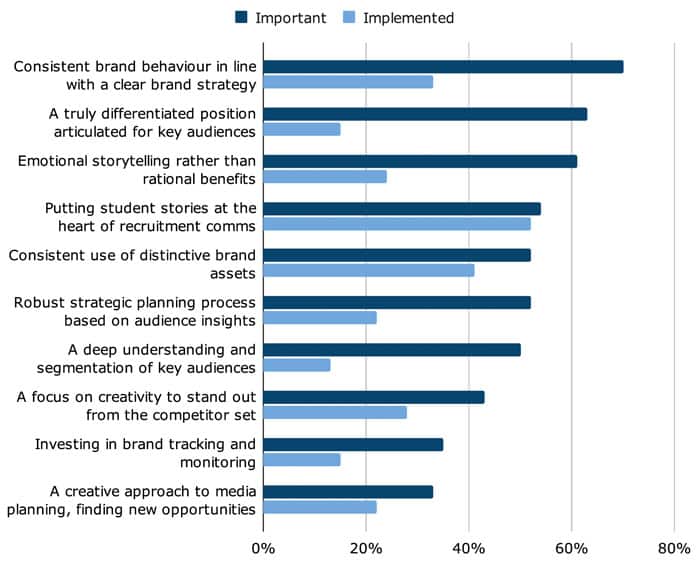What is holding back brand strategy in higher education marketing?
- A recent survey of higher education marketing specialists finds significant gaps between the ambitions and intent of marketers and actual brand development and execution within universities
- The findings point to a number of structural issues within institutions that are dampening brand efforts and preventing institutions from taking advantage of more differentiated and effective brand positions
There is a remarkable consistency in the brand strategies and related marketing communications offered by higher education institutions around the world. If you work in education marketing and have ever found yourself straining to find another way to say "world class" or "future focused" or even "bold" – or if you wonder how you ended up with so many "three and a tree"-type photos in your image bank – you may have just had a close encounter with that consistency.
Respondents to a new survey of senior HE marketing staff used terms like “serious,” “institutional,” “conservative,” and “obsolete” to describe university brands. Nearly three in four (72%) said they believed that university brands could not be counted among the world's most exciting brand identities. "Higher education marketers know what good looks like," says the survey report. "[They] understand brand. But too often, they see universities falling short, stuck in legacy behaviours, risk-averse in tone, or focused more on internal politics than audience resonance."
Those observations come from survey responses from 125 HE marketing professionals, primarily in the UK but with contributions from Egypt, Germany, Spain, and the US as well. The survey was jointly carried out in June 2025 by HE marketing consultancy Education Marketer and brand specialists Firehaus.
The survey findings are fascinating for the gaps they reveal between marketing and branding expertise within higher education institutions and actual practice within the sector.
For example, 81% of respondents said students should be involved in brand development, but only 23% engage students in that work. And while 75% said improving the university website is a priority, only 39% reported progress.
The following graph highlights similar gaps between important aspects of brand behaviour (that is, the ways in which a strong brand should "think and act") and the extent to which institutions are actually implementing those aspects.

"There’s broad agreement that universities should act with consistency, express a clear and differentiated position, and engage audiences through emotionally resonant storytelling," says the report. "These are behaviours grounded in well-established brand thinking, but they remain far from the norm in practice ... In a competitive environment, good brand behaviours are not optional extras. They are the building blocks of distinctiveness and long-term value. If consistency, differentiation and emotional resonance are widely agreed upon, their absence in delivery is not a creative issue. It is a strategic risk."
Mind the gap
When asked what gets in the way of more effective brand development, the survey respondents cited a number of issues, as illustrated in the following chart. Note that among the top responses are things like "Branding is seen as marketing's job only," or "Risk aversion," "Siloed departments," and "Internal politics."
Each of these responses reflects structural issues within institutions that constrain the development and execution of a more distinct or robust strategy. As one respondent, a senior marketer at a UK institution, put it, "We start off bold and dilute because of decision by committee. It’s embedded in the culture."
The report adds that, "The real challenge is that brand in HE is still too often treated as communication rather than behaviour. Institutions need to embed their brand strategy into daily decision-making and interactions to build relevance, trust, and loyalty over time."

The report authors sum up the situation like so: "The barriers HE marketers face are not marketing problems. They are organisational ones. Risk aversion, internal politics, and structural silos are not things that better campaigns can fix. Brand strength comes from alignment, clarity, and leadership commitment. Where those things are missing, brand-building will always stall. Institutions need to stop treating the brand as cosmetic and start treating it as core infrastructure. That shift begins at the top."
Scale of opportunity
The survey asked respondents what they would do with their branding if they had no barriers or constraints.
The responding marketers said they would reposition their institutions with greater humanity, clarity, and with a greater focus on students. "They described brands that are less formal, less stuffy, and more aspirational, empathetic, and student-centred," notes the report.
That student focus came through loud and clear at this stage of the survey, with marketers indicating they wanted to make much greater use of the student voice, and even to let students lead brand development. “Start with the students,” said one respondent, “their needs, wants, aspirations.”
Others saw an opportunity to build more dynamic and lively institutional brands, which the report characterises as: "Distinct, emotionally engaging, and unapologetically true to their purpose. The opportunity isn’t to invent more. It’s to express better."
"The raw ingredients for great branding are already present in universities: rich stories, social impact, diverse communities, world-class research and bold ideas," add the authors. "What is often missing is the strategic coherence and creative confidence to bring them together. Institutions that build their brands around what they can say and who they can be will cut through."
For additional background, please see:
Most Recent
-
ICEF Podcast: Engine of growth: The true value and impact of the international education sector Read More
-
Global higher education enrolments expected to grow through 2035, but new challenges must be addressed Read More
-
Canada: A case study of immigration policy impacts on postsecondary institutions and the wider economy Read More
















